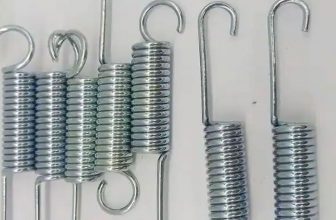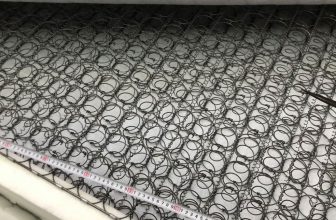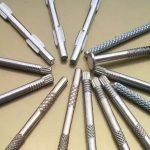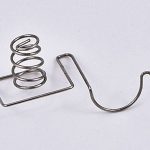
Springs are mechanical components that store and release energy, often used to absorb shock, maintain force between contacting surfaces, or return a system to a specified position. Traditionally, springs have been manufactured using methods such as coiling, stamping, or forming. However, the advent of 3D printing has opened up new possibilities for spring design and production, allowing for greater customization, complex geometries, and rapid prototyping.
Types of Springs in 3D Printing
Various types of springs can be produced using 3D printing technologies. Some of the most common include:
- Compression Springs: These springs are designed to compress under load and return to their original length when the load is removed. In 3D printing, compression springs can be printed with varying coil diameters and pitches, allowing for customization of their stiffness and load-bearing capacity.
- Tension Springs: Tension springs, or extension springs, operate in the opposite manner to compression springs. They are designed to stretch under load and return to their original length when the load is removed. In 3D printing, these springs can be created with integrated hooks or loops, enabling them to be directly incorporated into assemblies.
- Torsion Springs: Torsion springs work by twisting along their axis to exert a torque or rotational force. 3D printing allows for the creation of torsion springs with complex cross-sections and varied thicknesses, which can be tailored to specific rotational force requirements.
- Leaf Springs: Leaf springs are typically flat or curved strips of material that bend to absorb energy. While traditionally made from metal, leaf springs can be 3D printed from flexible materials such as thermoplastic elastomers (TPE) or even composites, providing unique flexibility and strength characteristics.
- Helical Springs: Helical springs, a subset of compression or tension springs, are wound in a helix and can be designed with varying numbers of turns, diameters, and material thicknesses. 3D printing enables the precise control of these parameters, allowing for springs tailored to specific mechanical properties.
Materials Used in 3D Printed Springs
The material used for 3D printing springs is critical, as it directly affects the spring’s mechanical properties, including its stiffness, strength, and fatigue resistance. Common materials include:
- Thermoplastics: Materials such as PLA (Polylactic Acid), ABS (Acrylonitrile Butadiene Styrene), and Nylon are frequently used in 3D printing for their ease of use and mechanical properties. However, their lower elasticity and strength compared to metals limit their use in high-load applications.
- Thermoplastic Elastomers (TPEs): TPEs are rubber-like materials that combine the ease of 3D printing with excellent flexibility and elasticity. These materials are ideal for printing springs that require significant deformation without permanent deformation.
- Composites: Composite materials, which combine a polymer matrix with reinforcing fibers such as carbon or glass, offer enhanced strength and stiffness. These materials can be used to print springs that are both lightweight and strong, making them suitable for more demanding applications.
- Metals: With the advent of metal 3D printing technologies such as Selective Laser Sintering (SLS) and Direct Metal Laser Sintering (DMLS), it is now possible to print metal springs directly. Metals such as stainless steel, titanium, and Inconel are used to produce springs with high strength, durability, and excellent fatigue resistance.
Advantages of 3D Printing Springs
3D printing offers several advantages over traditional spring manufacturing methods:
- Customization: 3D printing allows for the creation of springs with custom geometries tailored to specific applications. This customization can include varying the thickness, coil diameter, or pitch within a single spring, which is difficult or impossible with traditional manufacturing methods.
- Rapid Prototyping: 3D printing enables the rapid production of prototype springs, allowing designers to quickly test and iterate on designs. This can significantly reduce the time and cost associated with product development.
- Complex Geometries: Traditional spring manufacturing methods often impose limitations on the complexity of spring geometries. 3D printing, however, can produce springs with intricate shapes, such as lattice structures or variable cross-sections, which can provide unique mechanical properties.
- Material Efficiency: 3D printing is an additive manufacturing process, meaning material is added layer by layer rather than removed from a larger piece. This reduces material waste and can be more cost-effective, particularly for small production runs or customized parts.
- Integration into Assemblies: Springs can be directly printed as part of larger assemblies, reducing the need for additional manufacturing steps or assembly processes. This is particularly beneficial for complex mechanisms where the spring is a critical component.
Challenges and Limitations
Despite the advantages, 3D printing springs also presents several challenges:
- Material Limitations: While metal 3D printing is possible, it is still more expensive and less accessible than traditional methods. Additionally, many common 3D printing materials do not have the mechanical properties required for high-load or high-cycle applications.
- Surface Finish and Tolerances: 3D printed parts often have a rougher surface finish and lower dimensional accuracy compared to traditionally manufactured parts. This can affect the performance of springs, particularly in precision applications.
- Fatigue Resistance: The layer-by-layer nature of 3D printing can result in anisotropic mechanical properties, meaning the strength and stiffness of the spring may vary depending on the direction of the load. This can impact the fatigue resistance of the spring, particularly in cyclic loading applications.
- Cost and Accessibility: While 3D printing is becoming more affordable, the cost of high-quality 3D printers and materials can still be prohibitive for some users, particularly for metal printing. Additionally, the availability of suitable materials and the expertise required to design and print effective springs can be limiting factors.
Applications of 3D Printed Springs
The ability to rapidly prototype and customize springs has opened up new applications across various industries:
- Automotive: In the automotive industry, 3D printed springs are used in prototypes and small-scale production of custom parts, such as suspension components or return springs in complex mechanisms.
- Aerospace: The aerospace sector benefits from the weight savings and complex geometries possible with 3D printed springs, particularly in applications where custom springs are required for limited production runs.
- Medical Devices: In the medical field, 3D printed springs are used in custom implants, prosthetics, and surgical instruments. The ability to produce springs with specific mechanical properties tailored to individual patients is a significant advantage.
- Consumer Products: 3D printed springs are also finding their way into consumer products, particularly in custom or small-scale manufacturing. Examples include custom mechanical keyboards, wearable devices, and toys, where unique spring properties can enhance the user experience.
Future Directions
As 3D printing technologies continue to evolve, the potential for 3D printed springs is likely to expand. Improvements in material science, particularly the development of new polymers, elastomers, and metal alloys, will enhance the mechanical properties of 3D printed springs, making them suitable for a broader range of applications. Additionally, advances in multi-material printing could enable the production of springs with gradient properties, where different sections of the spring have different stiffness or elasticity, tailored to specific loads or deformations.
The integration of 3D printing with other manufacturing processes, such as CNC machining or injection molding, could also lead to hybrid approaches that combine the strengths of multiple methods. For example, a spring could be 3D printed with complex internal geometries and then post-processed with CNC machining to achieve precise tolerances and surface finishes.
In conclusion, 3D printing is transforming the design and production of springs, offering unprecedented customization, rapid prototyping, and the ability to create complex geometries. While there are still challenges to overcome, particularly in terms of material properties and production costs, the future of 3D printed springs looks promising, with potential applications across a wide range of industries.









